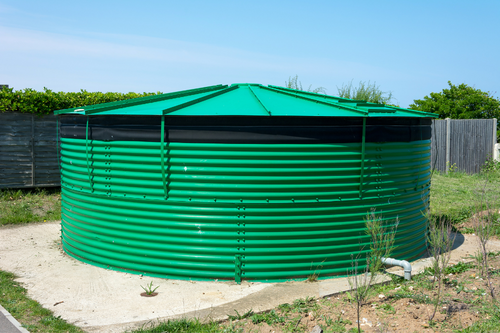How water storage has evolved over time and the role of tank liners
Over six thousand years ago people started to recognise the importance of water storage for drinking and agricultural purposes. The containment of water always came with the risk of contamination and so history also reveals the many different methods of purification used over time such as boiling, sun exposure and sand filtration.
As populations grew and civilisation left the Nomadic lifestyle establishing themselves in settlements often away from water sources such as rivers and springs, there was a growing need to store water. Homes and farms have continued to fill the country-side and with that came more reliable, purified water sources. But despite mains water supplies, water storage tanks still play an important role in industry, fire protection and agriculture.
Engineer and architect, Henry Robinson Palmer of the London Dock Company, was the first to design and patent the corrugated galvanised iron sheet in England, in 1829. The purpose for the corrugated metal sheet was to cover the platforms at the docks to protect cargo from all weather conditions. Corrugated iron proved of value in industry as it is light, inhibits corrosion (although rusting is inevitable over time if not protected), easily transportable and strong. It became a popular material in construction.
Then in 1844, Phoenix Iron Works, of Glasgow, patented a double-barrel fluted machine for corrugating iron. The patent included a curving machine to bend the corrugated sheet to the desired radius. This method is still used today to design and produce galvanised storage tanks. The use of metal sheeting made it's way into many different industries including the roofing for buildings. This is because metal sheeting offered many advantages. It doesn't leak, it is fire-proof, and resistant to damage by rodents.
Circular galvanised storage tanks were first patented in 1857 and soon became a prominent feature in many countries particularly in low-rainfall regions and farming communities. A century and a half later and they are still proving popular for collecting rainwater and water storage for fire protection. The first steel storage tank production involved riveting galvanised sheets together. In the 1920's this process was replaced by arc welding, which led to the production of a much higher quality storage tank. They became popular for successfully harvesting purer rainwater.

Advantages of galvanised steel storage tanks
Galvanised steel water storage tanks have a proven record for longevity. Water stored in these tanks is less susceptible to bacterial and algae growth versus concrete, wood or plastic containment. They are also corrosion resistant and will withstand adverse weather conditions.
Galvanized corrugated steel tanks are watertight. When installed with a tank liner, stored contents are prevented from contacting the steel container as a safeguard to prevent storage tanks from rusting.
Galvanised water storage tanks are used today to contain water for use in many applications such as: drinking water, irrigation, fire suppression, agricultural farming both for plants and livestock, chemical manufacturing, food preparation as well as many other uses. Tank parameters include the general design, choice of construction materials (plastics (polyethylene, polypropylene), fibreglass, concrete, stone, welded or bolted steel) and tank liner.
Existing tanks deteriorate over time and tank liners are a proven cost effective solution for repairing tanks of all shapes and sizes. The tank liner is fabricated to the exact size of the tank.
Although Russet Development Ltd main expertise lies predominately with EPDM, Butyl and SealEco rubber tank liner products, we are also able to offer alternative lining materials for the containment of more aggressive liquids or for the onsite lining of complicated shaped tanks where prefabrication is not an option. These other tank liner materials include Polypropylene, and Flagon Soprema synthetic liner of TPO modified Polyolefin and Flagon Soprema PVC.
Does your water storage tank need a tank liner installation or tank liner refurbishment? Are you looking to invest in a new tank? Contact RDL for a quote or for more information on our systems.